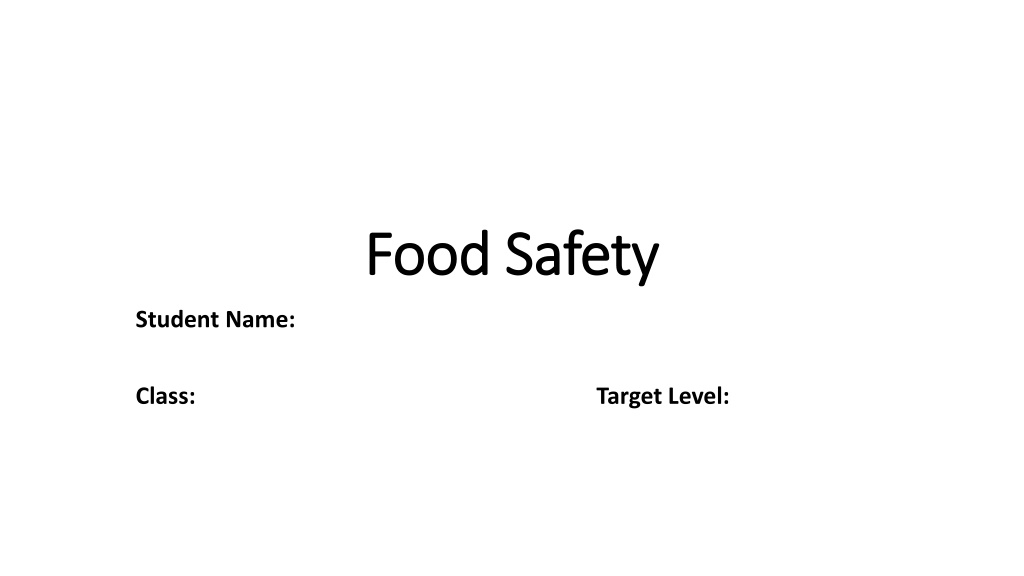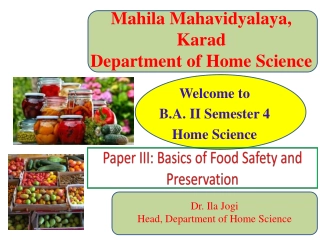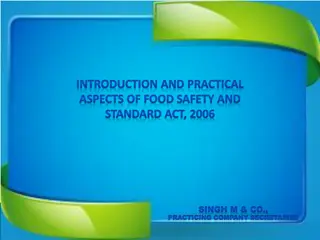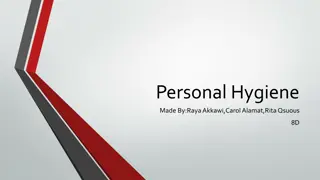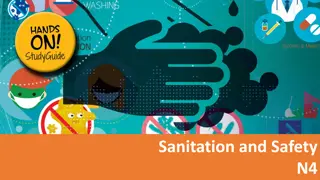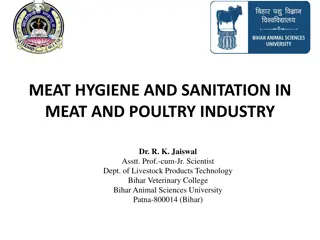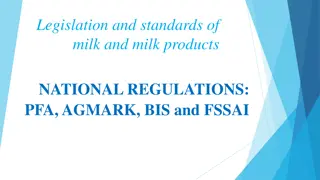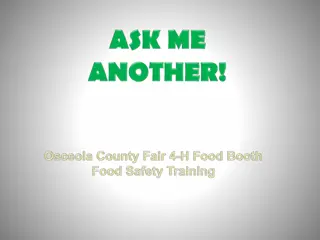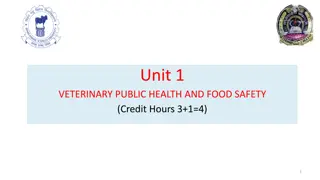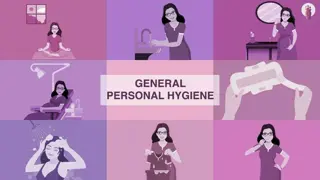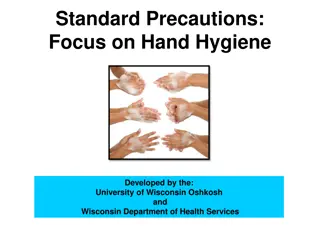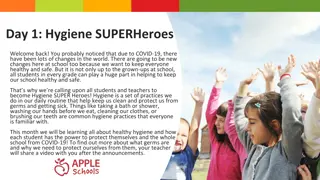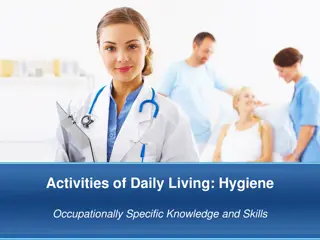Food Safety and Hygiene Standards Overview
When preparing and cooking food, personal hygiene and food safety standards are crucial to prevent foodborne illnesses. Learn about proper handwashing, handling high-risk foods, preventing cross-contamination, and understanding food poisoning bacteria risks.
Download Presentation

Please find below an Image/Link to download the presentation.
The content on the website is provided AS IS for your information and personal use only. It may not be sold, licensed, or shared on other websites without obtaining consent from the author.If you encounter any issues during the download, it is possible that the publisher has removed the file from their server.
You are allowed to download the files provided on this website for personal or commercial use, subject to the condition that they are used lawfully. All files are the property of their respective owners.
The content on the website is provided AS IS for your information and personal use only. It may not be sold, licensed, or shared on other websites without obtaining consent from the author.
E N D
Presentation Transcript
Food Safety Food Safety Student Name: Class: Target Level:
Preparing & Cooking Food Preparing & Cooking Food When preparing & cooking food it is important to have personal and food hygiene standards. Personal Hygiene: food handlers are a common source of pathogenic bacteria and contamination so personal hygiene must be of utmost importance: wear a clean apron, remove all jewellery, tie back hair, have short finger nails & no nail varnish. When should you wash your hands?
Preparing Food Preparing Food Food should be handled as little as possible Food must be kept out of the DANGER ZONE (5C 63C) as bacteria will multiply Prevent cross-contamination by keeping raw & cooked foods separate, using different equipment such as red chopping boards for raw meat. High-Risk Foods: protein based foods, moist foods & ready to eat foods are all at a higher risk of food poisoning bacteria contamination. They require strict time & temperature controls.
Food Hygiene 1. Which of the following are most at risk of food poisoning? a) Children and babies b) Elderly people c) People who are ill d) All of the above 2. Which of the following are bacteria? a) Salmonella b) E-Coli c) Bacillus Cereus d) All of the above 3. What do bacteria need to grow? a) Warmth b) Time c) Moisture d) All of the above 4. Which of the following are methods of killing bacteria? a) Boiling b) Sterilisation c) Drying d) Freezing 5. Match the temperatures to the places: a) Fridge -18 C b) Freezer c) Cooked food 3 C d) Within the danger zone 75 C 6. Which of the following is most likely to cause cross- contamination? a) using ready to eat foods within their use-by date b) Placing ready-to-eat foods above raw foods in the fridge c) Using the same knife to cut raw chicken & cooked ham d) Storing raw chicken in a covered container at the bottom of the fridge 7. Which of the following are high risk foods? a) Poultry and meat b) Eggs c) Gravy d) Cooked rice e) All of the above 8. Which of the following are examples of preservation? a) Drying b) Pickling c) Freezing d) Irradiation e) All of the above 45 C
Bacterial Contamination Bacterial Contamination Bacteria are everywhere: on people, in the air we breath, on our food, equipment, soil, pets, pests & water. You can become ill if you eat food that is contaminated by FOOD POISONING BACTERIA Bacteria are microscopic. You cannot tell if a food is contaminated just by looking at it. We must control the conditions that allow bacteria to multiply & cause illness by using strict time & temperature controls
Food Poisoning Bacteria: complete the table Food Poisoning Bacteria: complete the table Pathogenic Bacteria Foods Affected Symptoms Onset Special Note Diarrhoea, vomiting, fever 12-36 hours May be fatal to the elderly & babies Found in human & animal excreta Staphylococcus Aureus Cooked sliced meat, Dairy products, Anything touched by hand Clostridium Perfringens Nausea, Diarrhoea, abdominal pain 8-22 hours Clostridium Botulinum Incorrectly canned meat, fish or vegetables 1-6 hours
Key points Key points Bacterial contamination is the presence of harmful bacteria in our food, which can lead to food poisoning illness. As a food handler, you must do everything possible to prevent contamination. Key Words: Pathogens, food poisoning, contamination Preventing Contamination: Preventing contamination is the key to food safety. Write down how we can prevent contamination:
Quick Quiz Quick Quiz What are the main symptoms of food poisoning? Name 3 bacteria responsible for food poisoning What are the typical sources of food poisoning? Which groups of people are most at risk of food poisoning?
Past questions Food Hygiene & Safety 1a) Name four factors which affect the growth of microorganisms. 1 ___________________________________ 3 ___________________________________4 ___________________________________ (4 marks) 2 ___________________________________ b) What are the three categories microorganisms are split into? 1 _____________________________2 _______________________________ 3 _____________________________ (3 marks) c) People can be a hazard in the production of food. Explain two ways in which people can be a hazard and explain how the manufacturer can prevent them. 1.________________________________________________________________________________________________________ _________________________________________________________________________________________________________ _________________________________________________________________________________________________________ 2.________________________________________________________________________________________________________ _________________________________________________________________________________________________ ( 4 marks) d) What is the difference between high risk and low risk foods? Give 2 examples of each. _________________________________________________________________________________________________________ _________________________________________________________________________________________________________ ________________________________________________________________________________________________________ _________________________________________________________________________________________________________ _________________________________________________________________________________________________________ _________________________________________________________________________________________________________ _________________________________________________________________________________________________________ ________________________________________________________________________________________________ (9 marks)
1a) Food, moisture, warmth, time, pH level. (4 marks) b) Yeast, moulds and bacteria. (3 marks) c) Clothes Lockers should be provided for the storage of non-work clothes. Clean white coats and aprons should be provided for staff to wear. Hair Hair should be clean. Hair nets/ hats/beard nets should be provided by the manufacturer and staff should be expected to wear them. Long hair should be tied back. Hands/nails Nails should be kept short. Sinks should be provided for staff to wash hands in regularly. Cuts should be covered with blue plasters and in some cases gloves should be worn. Jewellery All jewellery should be removed or covered by a plaster if it cannot be removed. Skin/mouth/nose All have very dangerous bacteria on them. Staff should be trained not to cough or sneeze near food. If ill, staff should not be at work. Award one mark for each point. One for each explanation. (4 marks) d) High risk foods are high in protein and moisture and provide the ideal growing conditions for micro organisms. Examples include raw meat, cooked meat and poultry, seafood, dairy products and cooked rice. Low risk foods do not provide the ideal growing conditions for micro organisms. They are generally high acid, high sugar or low moisture. Examples include pickles, chutneys, fruit juice, marmalades, jams and crackers, dried foods. 5 marks for each correct descriptions. 4 for examples. (9 marks) TOTAL /20 1-5 = 1 6-7 = 2 8-9 = 3 10-12 = 4 13 = 5 14-15 = 6 16 = 7 17 = 8 18-20 = 9
Micro Micro- -organisms in Food Production: Yeasts, organisms in Food Production: Yeasts, moulds & friendly bacteria! moulds & friendly bacteria! Cheese & yogurt is made using a starter culture which is a collection of friendly micro-organisms / bacteria. The right mixture of these friendly bacteria (starter cultures) is vital as it is this that gives the cheese its characteristic flavour & texture (e.g. camembert cheese is made using the P. Camemberti starter culture. Some cheeses rely on moulds for their flavour & other characteristic properties e.g. stilton & Roquefort. Starter cultures are also used to make dried meats: salami & pepperoni etc. Also yoghurt.
Micro Micro- -organisms in Food: Quick Test organisms in Food: Quick Test What is the most important bacteria used in food manufacturing? What is blue cheese treated with to give it its taste and texture? In what ways are probiotic cultures considered to have health benefits?
Food Hygiene Homework Food Hygiene Homework Explain why each of the foods in the following chart is high-risk & give details as to how you can prevent them from causing food poisoning when buying, storing, preparing & cooking food. Food why is it high-risk? How would you prevent it from causing food poisoning when buying & storing? How would you prevent it from causing food poisoning when preparing & cooking? Chicken Fresh cream cake Egg Minced beef Liver pate
